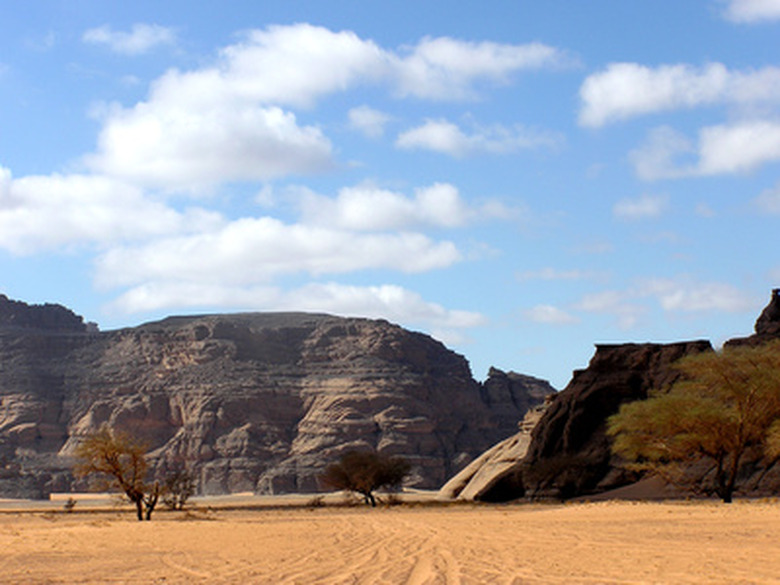Native Plants In Libya
Along the Mediterranean coast of Libya, a subtropical climate with dry woodlands and steppes supports plant life. In the country's interior, protected valleys provide habitat for plants as well as the rare oases dotted throughout the vast reaches of the Sahara Desert. Libya's native plants survive either with deep root systems and ephemeral life cycles such as sprouting, flowering and dropping seeds within two weeks after a rare rainfall, or by remaining dormant as a bulb or rhizome underground until favorable growing conditions return.
Along the Mediterranean coast of Libya, a subtropical climate with dry woodlands and steppes supports plant life. In the country's interior, protected valleys provide habitat for plants as well as the rare oases dotted throughout the vast reaches of the Sahara Desert. Libya's native plants survive either with deep root systems and ephemeral life cycles such as sprouting, flowering and dropping seeds within two weeks after a rare rainfall, or by remaining dormant as a bulb or rhizome underground until favorable growing conditions return.
Tahara
Blooming after rare rainfalls in the desert, tahara (Cornulaca monacantha) is a plant fed upon by camels, according to the Libyan company Temehu Tourism Services. This small woody shrub, a member of the smartweed family, grows about 2 feet tall and 3 to 4 feet wide. The green leaves are tiny, fuzzed and have a spine at their bases, turning yellow as soil moisture wanes and heat increases.
Branbakh
Libyans call this plant branbakh or albranbakh (Calotropis procera), while English names include giant milkweed, apple of Sodom and roostertree. Large, fuzzy gray leaves contain a toxin in their sticky, milky sap. The flower clusters occur on branch tips, comprising many lavender-purple star-like flowers that attract butterflies and bees for pollination. Growing 10 to 15 feet tall, branbakh produces golf ball-sized fruits that are air-filled and disintegrate when pressed.
- Along the Mediterranean coast of Libya, a subtropical climate with dry woodlands and steppes supports plant life.
- Libya's native plants survive either with deep root systems and ephemeral life cycles such as sprouting, flowering and dropping seeds within two weeks after a rare rainfall, or by remaining dormant as a bulb or rhizome underground until favorable growing conditions return.
Date Palm
A source of food and often a sign of a source of water, the date palm (Phoenix dactylifera) is native to northern Libya. In fact, the authors of "An Encyclopedia of Cultivated Palms" state that the date palm was likely originally found naturally only in North Africa until man spread its seeds across to other arid-region areas. This tall palm sports long, gray-blue fronds that have sharp spines. Trees are either male or female in gender. Both genders produce flowers, but only female plants bear the delectable orange fruits.
Oleander
Along the northern Mediterranean coast of Libya you'll find the oleander (Nerium oleander) growing as a shrub or small tree. Reaching 8 to 20 feet tall and 8 to 12 feet wide, this evergreen plant bears dark green, glossy leaves and beautiful five-petaled flowers of pinkish-red. Oleander tolerates both summer heat and drought as well as the salty air near the ocean.
- A source of food and often a sign of a source of water, the date palm (Phoenix dactylifera) is native to northern Libya.
- Both genders produce flowers, but only female plants bear the delectable orange fruits.
Alkhad
In western Libya this vining watermelon relative is called alkhad (Citrullus colocynthis) or tadjalt. English names include bitter apple and wild gourd. This annual or perennial herbaceous vine bears lobed, sandpapery textured leaves and rounded fruits that ripen to yellow with a diameter of 4 inches. The fruits taste bitter and are full of seeds and fibers. Only if soil moisture is adequate will plants persist for more than one growing season; the copious number of seeds permits survival by sheer numbers in various habitats across northern Libya.
References
- Temehu Tourism Services: Wildlife in the Sahara
- "An Encyclopedia of Cultivated Palms"; Robert Lee Riffle and Paul Craft; 2003
